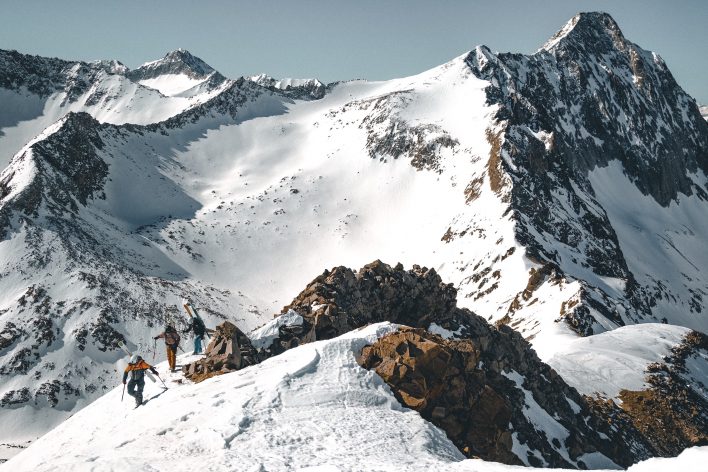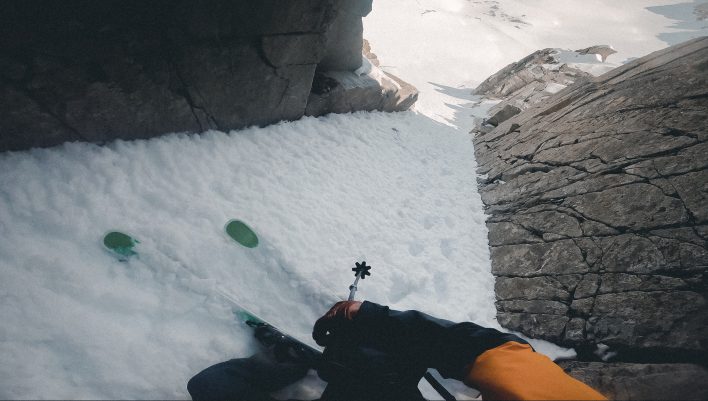
Peaks above 14,000 feet hold a certain cachet in the Lower 48. Most ranges in the continental U.S. don’t reach that threshold: Wyoming’s Grand Teton misses by 225 feet; the towering La Sals outside Moab, Utah, are more than 1,000 feet shy; the mighty Cascades, despite their prominence, are well short, save for Mt. Rainier and Mt. Shasta.
Colorado is the exception, with four times more of the high peaks than the rest of the Lower 48 combined. Its 14ers have a devoted following among ski mountaineers and peak baggers, including the more than 2,000 people and three dogs registered with the Colorado Mountain Club who have climbed all 58. Skier Michael Wirth, however, wanted to highlight the state’s next tier of high peaks—those above 13,000 feet; over 61 days last spring, he skied all 59 13ers in Colorado’s Elk Mountains, many of them solo.
At first, the 23-year-old had aspired to ski the Elks’ 14ers, a list that includes some of Colorado’s most challenging peaks—Capitol, North Maroon and Pyramid. But his mission soon changed. “After getting into it, I was realizing, ‘Well, a lot of people have—maybe not a lot of people—but people have skied the 14ers so far,’” Wirth says. “But nobody really books it for 13ers.”

The Elks lie between Aspen and Crested Butte, with no easy access into the heart of the range. The 13ers there see far less traffic than their loftier neighbors; some are subpeaks along ridges that might garner no more than a passing glance on the map. Trekking just a few miles into the range significantly diminishes the chances of encountering other skiers—as well as the amount of available information—says Aspen-raised guide Neil Beidleman, who helped evacuate climbers as part of the ill-fated 1996 Mt. Everest mission chronicled in Into Thin Air and The Climb: Tragic Ambitions on Everest.
That remoteness makes Wirth’s accomplishment all the more notable, adds Beidleman. “What really resonated with me about what Michael did for such a young kid is that he appears to be a student of the sport. He wasn’t just doing it on youth and vigor and hoping that things would work out. He took a very methodical, very logical approach.”
Someone of Wirth’s age doesn’t usually have the firsthand knowledge and wherewithal to pull off a feat of this magnitude, but with roughly a decade of backcountry experience under his belt, Wirth has been preparing for a while. He grew up in the nearby Roaring Fork Valley, dabbling in ski racing but mostly ripping around with his friends, a group of “local townie kids who were just making everybody mad by sit-tucking through moguls,” he says.
His first forays into backcountry skiing came under the tutelage of friends’ parents and some high school teachers. Wirth’s parents also made him take a Level 1 avalanche course, and on trips with a friend’s father, he became familiar with analyzing snow crystals and snowpack stability. “The forecast is amazing, but they’re forecasting for such big areas, so you’ve really got to dig your own pits and do your own thing,” Wirth says.
That self-sufficient attitude served Wirth well in his 13ers endeavor. Unlike many younger skiers who tackle their first major projects under the mentorship of older athletes, Wirth was mostly on his own in the Elks. He found beta for only nine or 10 peaks, so he studied maps and pictures to plan most of the ascents and descents. Even with that preparation, it was far from a cakewalk. Of the 59 peaks, he had at least six first descents and is waiting for confirmation on a seventh.
He tried to notch one, the northwest face of Lightning Pyramid, early on. “It was probably five or six days in, and the warming during the day that we went out there was particularly intense,” he says. “We had to turn around about 300 feet from the summit, and that just felt really, really horrible. Just being like, ‘Am I gonna be able to actually get to the top of that and ski from the summit?’”
The answer? Yes, though not until later in the spring. In addition to that first descent, Wirth was the first to ski the west face of the Sleeping Sexton and a line on the north side of Precarious Peak that he calls the Shark Fin. Though he had at least a trio of other first descents, he calls these three the projects’ cruxes. Over the first 30 days, Wirth estimates that he skied 25 peaks, leaving him 34 for the second month, but as he gained perspective on the Elks (along with more stamina), he was able to further push his limits.

The day he successfully skied Lightning Pyramid, he played the aspects to link it with Thunder Pyramid, an approach he replicated on several other days to tick off lines more quickly. Gaining knowledge of the snowpack so he could onsight the peaks and feel comfortable completing multiple objectives in a day was a highlight, Wirth says. “I was touching every aspect nearly every day in the Elks, so I had a really close and intimate understanding of what was happening with the snow.”
A movie about the project is slated to debut later this year, and Wirth is already starting a new venture that combines ski mountaineering with climate change awareness—though he wouldn’t divulge many details.
Longtime Elks skiers like Beidleman recognize the significance of skiing all the range’s 13ers. “You have to really pay attention to what you’re doing,” Beidleman says. “If you don’t, you’re going to end up in a big hurt or dead. A lot of these projects were really big days and to do many of them—if not most of them—on his own is a really substantial accomplishment.”
This article was originally published in The Generations Issue (No. 145) as part of a feature on young badasses pushing the backcountry skiing community forward. To read more, pick up a copy at BackcountryMagazine.com/145 or subscribe.










Related posts: